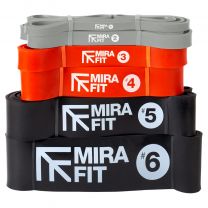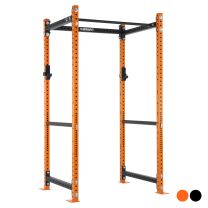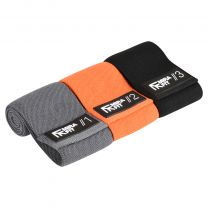Top 10 Resistance Band Benefits
Top 10 Resistance Band Benefits

Look around the gym and you’ll probably see a small pile of resistance bands somewhere – not being used.
Most of the time, people aren’t entirely sure how to use them. And often, they can simply get overlooked as it's not always clear how they can help you progress.
However, if you’re used to the cable systems at the gym – whether it’s to do tricep pull downs or seated cable rows – you’re already employing the same strength concepts that resistance bands are built on.
And because they’re so versatile, it doesn’t matter whether you’re looking to build, strengthen or work on an old shoulder injury, they have almost an infinite amount of uses and benefits.
You just need to know how to use them. But once you’ve got to grips with the basics, the benefits are tenfold.
Below, we cover all the fundamentals of resistance band training, including what they’re typically used for as well as the different types of exercises you can do with them.
What are resistance bands?

There are different types of Resistance Bands. The most common (and best) types are the flat, resistance bands which are also known as strength bands or exercise bands.
They come in different widths. The thicker the width of the band, the more resistance it provides and equally, the harder it is to use.
Resistance bands start at level 1 and go right up to level 6. They are all the same length, however the level 1 resistance band is easier to stretch. This means it's more suited to exercises that require a greater range of movement. And it's also slightly easier to use so ideal for anyone who is just starting out.
Moving up the levels, they get harder and harder to stretch out. Until you reach level 6, which provides the most amount of resistance and is the most difficult to stretch.
It also provides the most counter balance. So, if you're using resistance bands to support your weight while doing something like assisted pull ups, the level 6 band is a great one to opt for if you're just starting out.
They are made from rubber and can be looped round gym equipment such as a rack or a stand, or simply used on their own.
They can be knotted to make them smaller – this can help when targeting your lower body. Or you can use your feet to stretch and anchor the band, to suit your height and ability.
What do resistance bands do?

Resistance bands have a variety of uses
• To build strength - each band exerts a particular amount of force on your muscles when stretched and can be used in both upper and lower body training.
• To improve mobility - resistance bands are a great way to help you improve your flexibility, but you can also use them improve joint mobility.
• For rehabilitation - bands have proved themselves essential for aiding recovery and are especially useful when it comes to working on hip, shoulder and knee injuries.
• For weightlifting - resistance bands are also used in weight training. Wrapped around the ends of a weight bar, they make exercises more challenging so you can level up your one-rep max. Equally, they can be used with dumbbells for a similar reason.
• For pull ups - resistance bands can also help you build up to doing pull ups. Loop them around the pull up bar and place your foot or knee inside the band to support your weight as you train.
How to use resistance bands
You can also get a full body workout using just resistance bands. Here’s Danielle from MSP Fitness to show you her workout using a selection of our resistance bands.
Resistance band benefits

As you can see, resistance bands have all sorts of uses. And there are numerous benefits to including resistance band work in your training:
1 - They improve the quality of your exercises
When you think about resistance band training, the actual style of exercise is completely different than if you were using something like a dumbbell. Instead of simply lifting a weight, your muscles are under constant tension. This means the actual quality of each rep is significantly improved. And with your muscles working harder, you’ve got better contraction which is the key to getting stronger.
Additionally, it’s always good to find new ways to work out and provide your body with alternative stimuli to help it grow and adapt.
2 - They help to focus your control
Sometimes lifting heavy in the rack is a more preferred method of training compared to working with dumbbells, simply because you have a guaranteed level of form and consistency.
The more ‘free’ you get with your weights, the more effort you need to put in to controlling your movements to make sure you’re doing them right.
However, although they’re more difficult, doing more free-weight work is essentially going to help you get stronger. And it will also help you improve your functional fitness levels as well.
It really is about practice.
Using resistance bands can feel a little shaky at first and getting the feel for them simply takes time and regular use. Also, making sure you control both the tension and the release takes a good amount of concentration. You have to make sure you are maintaining the tension on the band – rather than letting them snap back into place.
3 - They recruit your stabilising muscles
We mentioned above how resistance bands can feel a little unsteady to use. This just means you need to work doubly hard to maintain your form.
But by doing this, you’re targeting your stabilising muscles and building core strength, all at the same time.
Try doing some overhead tricep extensions using a resistance band, and you’ll realise just how much you activate your core while doing them.
4 - They’re fundamental for functional training
There is a lot more movement involved when using resistance bands compared to more traditional style exercises. However, this is great for working your joints and allowing for more natural movements that you do in everyday life.
Building this sort of strength is great for helping you reach your goals but also stay fit and healthy in later life too.
5 - A great alternative to machines
Machines can be good for beginners as they teach you the general movements you need to be doing in order to target specific muscle groups.
However, they can be restrictive and can force you to move quite unnaturally – depending on your body type – which means you’re not getting the most out of your workouts.
Being able to work the full muscle from extension to contraction will give you the best the results – and that’s what you get with resistance bands.
6 - They’re lightweight
Having a set of resistance bands can really help if you can’t get to the gym, or if you want to train at home without taking up loads of space. You can also take your own set to the gym really easily. Just chuck them into your gym bag and you’re all set.
Equally, if you travel around a lot and you want to make sure you get a workout in, you can just take them with you and use them wherever. You can even take them on holiday with you so there’s no excuse not to keep your strength up while you’re away.
7 - They’re designed for compound exercises
Compound exercises are when you use several muscles at the same time. They make for a really efficient workout as well as use more energy and improve your coordination.
Resistance band exercises are naturally more geared towards compound movements, so you can use them to get a full body workout.
8 - You have control over the angle
Straight bars are great for lifting heavy. However, if you have any shoulder or wrist issues, they can sometimes aggravate your injuries. When using resistance bands, you can control the angle you train at. This means you can avoid training in uncomfortable positions while still targeting the right muscle groups.
And even if you’re not injured, it’s always worthwhile varying your training as much as possible to help avoid straining your joints.
9 - They promote better form
How many times have you used momentum to squeeze out the last few reps while doing a particular exercise? This is much harder to do when using resistance bands. Having to maintain tension on the bands throughout the workout means each rep needs to be high quality and your muscles need to be working hard the whole way – rather than just at the end of the rep.
Ultimately however, this is going to help you progress and develop. So, they are a really fantastic training tool for anyone looking to build all over body strength.
10 - They teach you to feel what’s working and what isn’t
Because you have so much control over how you are using the band – from set up, to positioning, angle and movement – you need to be really focused on the feel of each exercise so you can tell what you’re working.
And once you know you’re working the right muscles, you can focus on squeezing them right until the very end to make sure you’re getting a full contraction.
Employing resistance bands in the right way can really help you improve the quality of your workouts. And they’re really convenient too.
Looking to do more? Check out our complete upper body workout using resistance bands.
For more content, follow us on Instagram, YouTube, TikTok, and on our official Mirafit Facebook page.
Enter your email to signup to our newsletter
Tags: Equipment > Resistance Bands ; Exercise Type > Conditioning








